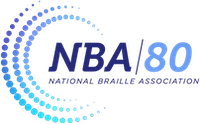Enclosure Indicator
Home › Forums › Unified English Braille Technical › Enclosure Indicator
- This topic has 7 replies, 3 voices, and was last updated 8 months ago by
kdejute.
-
AuthorPosts
-
February 4, 2025 at 2:56 pm #43431
Anne Lattanzi
ParticipantPlease see attached PDF
Attachments:
You must be logged in to view attached files.February 6, 2025 at 12:56 pm #43443kdejute
ModeratorOooh! These are intriguing and clever questions! I will try to respond to them one at a time. –Kyle
February 6, 2025 at 1:05 pm #43444kdejute
ModeratorFirst, if you use only a checkmark to indicate a checkmark-within-a-circle, I would likely applaud your choice to simplify where appropriate. The explanation of this checkmark usage should go on the Transcriber's Notes Page. It would probably be appropriate to identify the checkmark itself on the Special Symbols Page, but the use of only a checkmark where print shows a checkmark inside of (or on top of) a circle, is a braille formatting choice and so belongs on the Transcriber's Notes Page. (BF2016 §3.1.1's second paragraph and RUEB §3.28)
–Kyle
February 6, 2025 at 4:31 pm #43447kdejute
ModeratorSecond, if we have to show a transcriber-defined symbol enclosed in a circle, I agree that the following would be the best way to do so (using "physical enclosure" as illustrated in GTM §14.3.1).
;;$=[?
That symbols-sequence is a grade 1 word indicator, the two-cell symbol for a circle (shape indicator and a full cell), the physical enclosure cell, the first transcriber-defined symbol, and then space.
You have likely already considered all angles of:
- using the transcriber-defined symbol vs. the transcriber-defined shape
- with what words you will identify whatever transcriber-defined thing you use
- where you will identify whatever transcriber-defined thing you use (i.e., on the Special Symbols Page or in a list of special symbols within the text)
I do think this would be understood by a 10th grade student. 😊
🧠
Finally, does the termination of a shape leave the rest of the symbols-sequence in grade 2 (unless it is affected by a grade 1 word or passage indicator)? ... Many agree with your assessment that according to RUEB2024 §2.5.3, it does. However, the first example in GTM §14.3.1 might indicate otherwise.
RUEB2024 §2.5.3 says, "Grade 1 mode exists only when introduced by a grade 1 indicator or by a numeric indicator."
The first example in GTM §14.3.1 is: ;$=["6 (circle enclosing a plus sign) where the cell dots 2-4-6 does not have any grade 1 indicator or numeric mode affect it, BUT it is treated as if it has its grade 1 meaning (physical enclosure). Maybe the argument is that what's physically enclosed is part of the shape and so affected by the shape indicator's limited grade 1 mode (though that would be quite a unique effect for an indicator to have).
This issue is on the list of things to be clarified by ICEB's technical material code maintenance committee. Right now, I would follow RUEB2024 §2.5.3, as you have suggested.
🧠
February 6, 2025 at 4:40 pm #43448kdejute
ModeratorThird, if we need to indicate "circling" (that is, physical enclosure in a circle) of a symbols-sequence that consists of more than one item, then yes, using braille grouping indicators is a good solution.
The example you shared is a simple up pointing arrow and a dollar sign circled together:
;;$=[<\+@s>
That symbols-sequence is a grade 1 word indicator, the two-cell symbol for a circle (shape indicator and a full cell), the physical enclosure cell, opening braille grouping indicator, the two-cell symbol for a simple up pointing arrow, the two-cell dollar symbol, closing braille grouping indicator, and then space.
February 6, 2025 at 4:56 pm #43449kdejute
ModeratorLast, but not least, you asked, "Wouldn't the enclosure symbol be easier to understand when preceded by the shape termination symbol?"
I cannot say whether that would be easier to understand. However, I can point out that section 14.3 is titled "Combined shapes," and its first paragraph says that physical enclosure takes two symbols and makes a new, previously undefined symbol. For example, the "circled plus" is a single entity with a meaning all its own that is distinct from the "plus" and the "circle." So, the enclosed shape is part of the overall shape, and it would be inappropriate to put a shape terminator between the circle and whatever is enclosed.
I think the next necessary question is, "Does physical enclosure accurately transcribe the meaning of 'circling' in print (like "circle the correct answer")? ... Or would a typeform perhaps do a better job of transcribing the meaning of 'circling' while physical enclosure should be reserved for situations where the enclosing and enclosed shapes become something different from either (like the circled plus described above)? I do not have an answer to that question, and I suspect no one else does for sure either, for now.
Thank you for sharing your astute questions!
Please let us know if you need anything more or different.
–Kyle
April 23, 2025 at 12:19 pm #43733MenWithAMessage
ParticipantSorry for the delayed response! Thank you so much for your very helpful answers and thoughts!!! 🙂
Annie Lattanzi
-
This reply was modified 8 months ago by
MenWithAMessage.
April 23, 2025 at 1:56 pm #43735kdejute
ModeratorSo happy to help!
-
AuthorPosts
Everyone is free to read the forums, but only current NBA members can post. Become a member today. Click here to Login and return.
